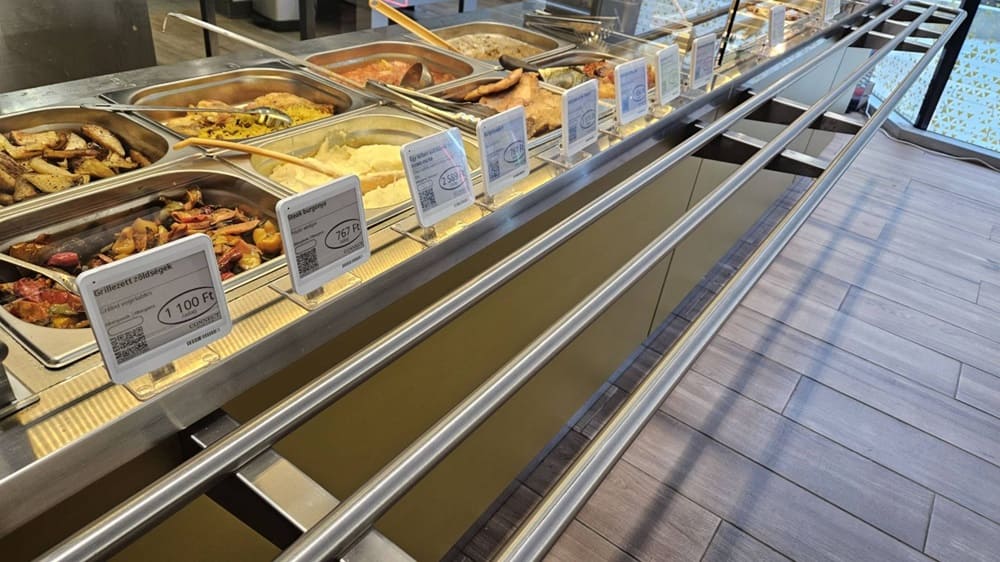Buffet labels may look small, but they carry serious weight. For restaurants, hotels, and caterers, they're not just name tags for food—they're tools that drive clarity, consistency, and confidence in every dining setup. And as food service evolves, so have the products used to label dishes. What started with folded cards and chalkboard tags has grown into dynamic, digital labeling systems that simplify operations and elevate the guest experience.
This article explores the shift from traditional DIY labels to modern digital solutions. You'll learn the strengths of each product type, when to use them, and why more operators are choosing to upgrade.
DIY Buffet Food Labels
DIY buffet labels are where most operations begin. They're practical, low-cost, and can be made using tools you already have—paper, printer, scissors, maybe a marker or two.
These labels usually come in the form of folded tent cards, printed inserts, or mini chalkboards. You'll find them in small restaurants, at catered events, or on hotel breakfast lines where the menu changes slightly each day. They're great when you need quick solutions or are working with a tight budget.
What makes them work:
Easy to produce and update
Customizable to match event or brand style
Ideal for rotating menus or one-off setups
Where they fall short:
Susceptible to damage from heat, spills, or humidity
Inconsistent appearance if handwritten by different team members
Not ideal for multilingual content or detailed dietary info
Labor-intensive when menu items change frequently
As your services become more complex, they may not scale well.
Upgrade to Digital Buffet Labels
As buffets evolve, so do guest expectations. That's where digital buffet labels come in. These are electronic displays—typically e-ink panels—that show dish names, dietary icons, and other info in real time.

Unlike DIY cards, digital labels can be managed from a central system. Whether you are updating breakfast items at a single venue or syncing menus across multiple outlets, everything happens instantly, without printing or manual setup.
What they bring to the table
Real-time updates from any connected device
Built-in support for multiple languages and dietary icons
Clean, consistent visual design across all stations
Ability to include extended info like ingredients or nutrition facts
They're especially valuable in environments with frequent menu changes—like hotels with breakfast, lunch, and dinner service—or where branding and polish are part of the guest promise. While the upfront investment is higher, digital labels often save labor hours, reduce paper waste, and help maintain accuracy across busy service periods.
Why More Operators Are Switching to Digital
Digital buffet labels aren't just about aesthetics—they solve real problems in food service.
1. Easier updates for complex menus
When you serve different items throughout the day or across multiple stations, manually replacing cards becomes inefficient. Digital systems let you make updates once and push them everywhere.
2. Multilingual and allergen-friendly
For international guests or those with dietary restrictions, clarity matters. Digital labels allow you to show multiple languages, allergen warnings, and icons—all on the same screen without clutter.
3. Stronger brand presentation
Uniform screens, consistent formatting, and modern design help reinforce a high-quality brand image. Although it is a small detail, it conveys the professionalism of the brand to guests and provides a better dining experience.
4. Long-term time and cost savings
Digital systems reduce the need for daily label prep, printing, and reprinting. Over time, they streamline operations and free up staff for higher-value tasks.
Choosing the Right Product for Your Operation
There's no one-size-fits-all answer. The right buffet labeling product depends on your service style, budget, and how often your menu changes.
DIY labels still work well if you:
Run small or one-off events
Have a fixed, simple menu
Need low-cost, quick turnaround solutions
Digital buffet food signs are the better fit for:
Offer rotating menus or multiple daily services
Serve international or allergen-sensitive guests
Want consistent design across all locations
Aim to modernize and scale buffet presentation
A hybrid approach is also a practical option for many operations. For example, some restaurants continue using printed labels for staple items that rarely change—such as bread, fruits, or salad greens—while reserving digital displays for areas that require more flexibility, like hot dishes, daily specials, or rotating seasonal items. This allows teams to balance cost, efficiency, and visual consistency.
Power Your Buffet with MinewTag Digital Labels
MinewTag offers smart, customizable digital buffet label solutions designed for modern foodservice environments. With wireless connectivity, centralized management, and support for multilingual content, MinewTag's displays make it easy to present real-time information across any buffet setup—whether it’s a single breakfast bar or a multi-outlet hotel dining system. Built for efficiency, durability, and brand consistency, MinewTag helps foodservice operators reduce labor, minimize printing waste, and deliver a polished guest experience.
If your buffet is growing, your labels should evolve too. A good labeling system helps your team stay organized, makes the dining experience clearer for guests, and adds a polished touch that reflects well on your brand.











